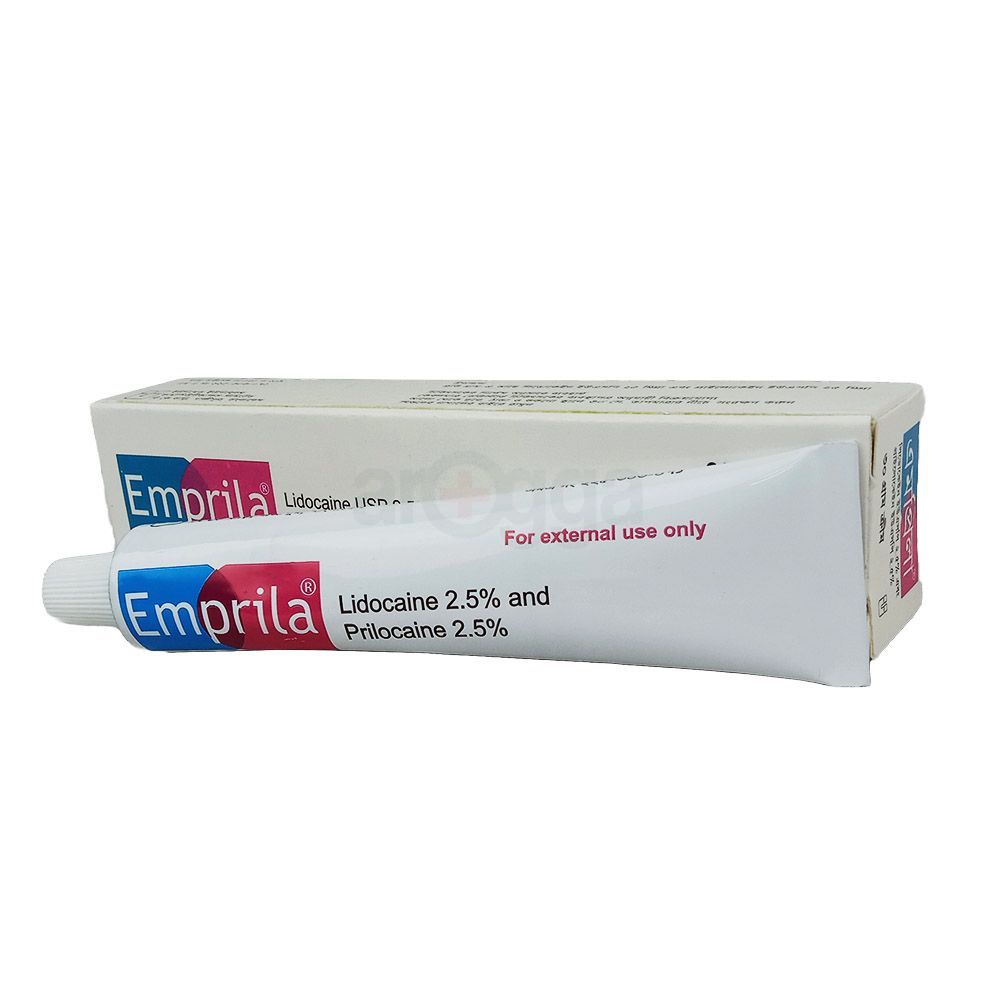

12-24 Hours
ব্যবসার জন্য পাইকারি দামে পণ্য কিনতে রেজিস্টেশন করুন
Register
0 People recently viewed this
Emprila
Unimed Unihealth Pharmaceuticals Ltd.
Generic: Lidocaine + Prilocaine topical
Safety Advices
বাংলা
English
SAFE IF PRESCRIBED
Emprila is generally considered safe to use during pregnancy. Animal studies have shown low or no adverse effects to the developing baby; however, there are limited human studies.
CONSULT YOUR DOCTOR
Emprila is probably unsafe to use during breastfeeding. Limited human data suggests that the drug may pass into the breastmilk and harm the baby.
Medicine Overview of Emprila 2.5%+2.5% Cream
Introduction
Emprila is a combination of two local anesthetic medicines, that helps to numb the area where it is applied. It is used on normal or unbroken skin to prevent pain before certain procedures like inserting a needle, suturing of a wound etc. Emprila works by temporarily numbing the skin and surrounding area. It should be used in the dose and duration as advised by your doctor. This medicine is for external use only. Make sure that the affected area is clean and dry before applying this medicine. Apply a thin layer and rub it gently to form a layer of...
... Show moreUses of Emprila
- Local anesthesia (Numb tissues in a specific area)
Side effects of Emprila
Common
- Application site reactions (burning, irritation, itching and redness)
- Rash
How to use Emprila
This medicine is for external use only. Use it in the dose and duration as advised by your doctor. Check the label for directions before use. Clean and dry the affected area and apply the gel. Wash your hands after applying, unless hands are the affected area.
How Emprila works
Emprila is a combination of two medicines: Prilocaine and Lidocaine/Lignocaine. It works by blocking pain signals from the nerves of the affected area to t he brain. This decreases the sensation of pain.
Quick Tips
- Emprila must be applied over intact skin and cover with treated area with dressing.
- Do not apply it to broken or infected areas of skin, face, eyes or eyelids unless specifically instructed by your doctor.
- Wash your hands properly with soap before and after applying the medicine.
- Avoid contact with the eyes, mouth, nose or any mucous membrane and rinse thoroughly in case of accidental contact or seek medical help in case of ingestion.
- It may cause minor burning, stinging, or irritation when applied. Inform your doctor if this does not go away.
Brief Description
Indication
Local anaesthesia
Administration
Apply a thick layer to intact skin and cover with occlusive dressing.
Gently squeeze cream out of the tube as a narrow strip that is 1.5 inches long and 0.2 inches wide; 1 strip corresponds to 1 g
Perform local anesthetic infiltration immediately after removal of cream
Male genital skin: Analgesia will increase up to 3 hours under occlusive dressing and persist 1-2 hours after cream removal
Female genital skin: Occlusive dressing is not necessary but will keep cream in place
Adult Dose
Topical Dermal Procedures Minor dermatological procedures (e.g. IV cannulation or venipuncture): Cream: Apply 2.5 g over 20-25 cm² of skin surface area for at least 1 hr Painful dermatological procedures involving large areas (eg, split thickness skin graft harvesting) Cream: Apply 2 g/10 cm² of skin and allow to remain in contact with the skin for at least 2 hr Analgesia is achieved in 1 hr, reaches maximum in 2-3 hr, and persists 1-2 hr after removal Topical Anesthetic on Genital Mucous Membranes Superficial minor surgery on male genitalia and as pretreatment for infiltration anesthesia Cream: Apply 1 g/10 cm²...
... Show moreChild Dose
Local Anesthetic Procedures
Cream
Neonates (gestation age 10 cm²/>1 hr application time
3-12 months (and >5 kg): Do not exceed 2 g total dose/application area > 20 cm²/>4 hr application time
1-6 years (and >10 kg): Do not exceed 10 g total dose/application area > 100 cm²/>4 hr application time
7-12 years (and >20 kg): Do not exceed 20 g total dose/application area > 200 cm²/>4 hr application time
Contraindication
Neonates with gestational age <37 wk. Infants <12 mth of age who are receiving treatment with methaemoglobin-inducing agents or children who are receiving medications associated with drug-induced methaemoglobinemia. Children with congenital or idiopathic methaemoglobinemia. Application on mucous membranes, broken or inflamed skin.
Mode of Action
Lidocaine and prilocaine are local anaesthetic agents of the amide type. Both work by stabilising the neuronal membranes and inhibiting the ionic fluxes required for the initiation and conduction of impulses, thereby giving rise to the anaesthetic action.
Precaution
Caution when used over large areas and leaving on for >2 hr. Severe hepatic impairment. Caution when used in patients who are receiving class I and III antiarrhythmics. Dose reduction may be necessary in acutely ill, debilitated patients and elderly. Avoid using on open wounds or near the eyes. Pregnancy and lactation.
Lactation: Excreted in breast milk; use not recommended
Side Effect
>10%
Pallor/blanching (37%),Application site erythema/pain (30%),Genital mucous membrane burning sensation (17%),Oral cavity, periodontal formulation (15%)
1-10%
Alterations in temperature sensations (7%),Application site edema (6-10%),Itching (2%)
<1%
Rash,Myocardial dysfunction (rare),Methemoglobinemia (rare),Depression/excitation (rare),Seizure (rare)
Frequency Not Defined
Localized discrete purpuric or petechial reactions (rare)
Localized hyperpigmentation (rare)
Allergic reactions (eg, urticaria, angioedema, bronchospasm, shock)
Interaction
Increased risk of toxicity when used with drugs that are known to cause methaemoglobinaemia. Concurrent use with class III antiarrhythmics may lead to additive cardiac effects. Toxic effects may be additive when used with class I antiarrhythmics.
ব্যবসার জন্য পাইকারি দামে পণ্য কিনতে রেজিস্টেশন করুন
Register